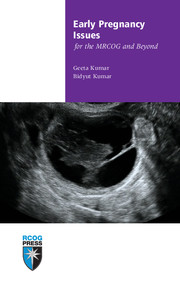Book contents
- Frontmatter
- Contents
- Dedication and acknowledgement
- About the authors
- Abbreviations
- Preface
- 1 Embryogenesis and physiology
- 2 Miscarriage
- 3 Recurrent miscarriage
- 4 Ectopic pregnancy
- 5 Trophoblastic disease
- 6 Hyperemesis gravidarum
- 7 Abdominal and pelvic pain in early pregnancy
- 8 Prescribing issues
- 9 Ultrasound and screening
- Further reading
- Index
- Published titles in the MRCOG and Beyond series
9 - Ultrasound and screening
Published online by Cambridge University Press: 05 July 2014
- Frontmatter
- Contents
- Dedication and acknowledgement
- About the authors
- Abbreviations
- Preface
- 1 Embryogenesis and physiology
- 2 Miscarriage
- 3 Recurrent miscarriage
- 4 Ectopic pregnancy
- 5 Trophoblastic disease
- 6 Hyperemesis gravidarum
- 7 Abdominal and pelvic pain in early pregnancy
- 8 Prescribing issues
- 9 Ultrasound and screening
- Further reading
- Index
- Published titles in the MRCOG and Beyond series
Summary
The main intentions of introducing the early pregnancy scan were to confirm viability of the gestation and to measure the fetal crown–rump length (CRL). However, in recent years, improvement in the resolution of ultrasound machines has made it possible to describe the normal anatomy of the fetus and to diagnose or suspect the presence of a wide range of fetal defects in the first trimester of pregnancy. Transvaginal ultrasonography (TVS) is widely used to assess early pregnancy and is considered to be safe for the developing embryo.
Visible signs of pregnancy
Around the time of implantation, a thickened hyperechogenic homogenous endometrium is detectable and is usually referred to as the ‘decidual reaction’. A corpus luteum is usually seen in one of the ovaries showing a cystic or echogenic (haemorrhagic) pattern with typical peripheral blood flow resembling a ‘ring of fire’ on colour Doppler examination. The first visible sign of a definite pregnancy on TVS has been seen from days 28–31 with the appearance of the gestation sac, which appears as an uniform round hypoechoeic structure with an echogenic rim, asymmetrically situated within the decidua near the uterine fundus.
At about 35 days, the secondary yolk sac makes its appearance and has developed from a layer of extra-embryonic endoderm and a layer of extra-embryonic mesoderm outside it. It is a spherical hyperechoic ring eccentrically situated within the gestation sac. The yolk sac increases in size until it begins to regress at around 9 weeks of gestation and usually disappears by 12 weeks.
- Type
- Chapter
- Information
- Early Pregnancy Issues for the MRCOG and Beyond , pp. 110 - 120Publisher: Cambridge University PressPrint publication year: 2011



